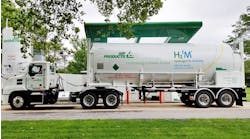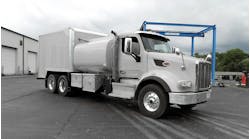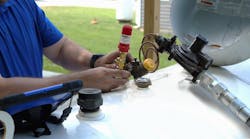ALAN Tomlinson, solutions engineer for TMW Systems, said it was a bit of an oxymoron to title his presentation, “Paperless Tank Wash Process,” since he doubts that a tank could be cleaned without doing any paperwork at all. But paperwork can be virtually eliminated by TMW Systems' software designed to track a maintenance facility and solve the “business problem” faced by facilities.
Tomlinson reviewed options for eliminating paper documents from the tank cleaning process during the National Tank Truck Carriers' Tank Cleaning & Environmental Council annual seminar June 4-5 in New Orleans, Louisiana.
“We want to collect data quickly and efficiently so we can track fleet and customer wash tickets by unit and wash rack, integrate to accounting and dispatch products so we're not entering data multiple times, track wash-bay costs for analysis so we can analyze it because we are in business to save money, and better control the tank-wash facility,” he said.
The tracking requirements:
-
Identify what cleaning actions must be performed for specific commodities. “Documenting those things is very important.”
-
Track what cleaning processes were performed in which wash bay, and the time taken for each.
-
Produce a “cleaning certificate” indicating what cleaning processes were performed on a vehicle.
-
Historically track when and what cleaning processes were performed on which vehicles.
-
Expense and/or bill-out (and invoice) specific wash processes at a variety of charge-out rates. “So your billing is consistent and accurate. The last thing you want to see is a bill that was $197.52, and next week you get one for $247.87, and it's the same thing.”
-
Easily and quickly record the information without massive or complicated clerical efforts. “That's a big one. Paper is good for what it is, but it's hard to do reports on and hard to look stuff up. It can be lost and get damaged.”
-
Capture information to provide reporting for state and federal governmental oversight agencies.
-
Interface transaction data into your profit and loss, accounts receivable, and accounts payable statements.
-
Schedule and predict required recurring cleaning activities on specific vehicles.
-
Collect and track “heel” from each wash and the drum number it was collected in.
He said this can be accomplished with software that provides touch-screen technology that is simple and easy, accurately captures data, and can be used on a mobile notepad or on a 17-inch monitor.
Two methods
There are two methods:
- Method 1.
“Wash tickets are created by the shop planner or the dispatcher and can be assigned to the wash bay. You're a large enough company, so you know this stuff needs to be washed. One of our dispatch products interfaces directly into the maintenance system from the tank-cleaning scenario.
“You have some type of wash-ticket demand. You have a driver pulling up, saying, ‘I need to get the tank washed.’ You get a wash ticket set up and sent over from some sort of dispatch system. The shop foreman creates a plan. The tank to be washed is assigned to a bay. The technician will log in a wash job. They'll perform the wash job per the order. Once that's finished, they enter the heel collection information. This is where the tank-wash technician will record all services performed. Standard jobs — like a caustic wash, rinse, or an exterior wash — could be priced at standard amounts. There are about a hundred of them, and all of them can be pre-defined in the repair program.
“Is the wash complete? If not, you might go to another bay and park it and schedule it for tomorrow to finish up. Or you might have a chassis problem that needs to be fixed. If the work is complete, they give a completed print wash certificate to give to the driver. We recommend you have a supervisor review the order for accuracy. You can print the customer invoice if required. This is the most involved method.”
- Method 2.
“It's the same, except wash tickets are created by wash-bay technicians at the time of cleaning. When the truck enters the bay, the technician does the wash or whatever needs to be done. A tank-wash order has already been created, and they'll know what commodity is in the tank. After he's finished with the wash, he can log into the wash job and get all parts, labor services, and everything they did to it, and close it out. That's faster.”
Tomlinson said there are combined methods that are not limited to one method or the other.
“Each method can be used alone or in combination,” he said. “Our system is based on an individual shop or facility, so you can set up one facility to work one way and another facility another way.”
-
Step 1: Technicians log in to work.
“The system tracks each technician for a payroll timecard. We don't track each technician for each tank wash because the technician can wash multiple tanks at the same time.”
-
Step 2: Log-in each tank trailer to the wash bay.
“It tracks each unit in each bay. It's time tracking for the length of wash. It's good information for you as managers. How much time does it really take? You can get cost analysis out of this.”
-
Step 3: Create a tank-wash repair order.
“We use a set of the VMRS codes to track actual washes. Or we can go all the way down to the commodity if you want to go that far in tracking. Each one of those component codes, in this case a specific wash time, can have a job code. That's a specific job: brake job, oil change, caustic wash, rinse, exterior wash. There's a pre-set list of items that have to be checked off. This is how you can control that documentation. You can't close a repair order until these things are checked off. I can also require them to record something and put a comment in. We've added a new feature where there is a button where you can attach a file like an MSDS or special instructions for that task within a particular job.”
-
Step 4: Review for accuracy, close the wash ticket, and create a tank-wash invoice. “You can set it up so the ‘close’ button closes the whole thing.”








